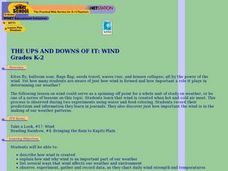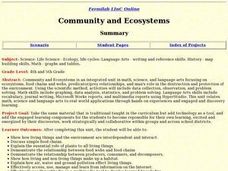Curated OER
Melting Ice
Students observe the melting of ice and explore the basic physical changes that occur. They gain information of how different substances change the rate of melting. Students discuss the properties of water and ice, the definition of...
Curated OER
Guess What?!
Students explore how scientists work. In this scientific method lesson, students use their senses to identify objects they cannot see. Students are asked to think like scientists and make observations, comparisons, and interferences, as...
Curated OER
Your Body: A Bacteria Incubator!
Students use string, a petri dish, water, wipes, and other materials to collect bacteria from their body. In this bacteria lesson plan, students use ingredients to collect bacteria, observe it, predict what will happen over time, and...
Curated OER
The Improvement of the Electric Light Bulb
Young scholars study how the first electric light was made and the history behind it. In this electricity lesson students create their own light bulb.
Curated OER
A Journey Through Our Solar System
Students investigate the concept of the solar system in our universe by constructing a model that is made to a measurable scale. Once the model is constructed it should be placed in a wide open space for observation and demonstration...
Curated OER
Properties of Matter
Second graders investigate how objects can be described, classified and compared by their composition. They recognize that the same material can exist in different states. Students verify that things can be done to materials to change...
Curated OER
Organisms and Their Environment
Students explore Earth's biosphere. In this biosphere lesson, students participate in group activities regarding biotic and abiotic factors, population density, and species' habitats.
Curated OER
Pop Rockets
Pupils work together to design and build a paper rocket. They place a propellant in the contraption to make it fly. They discover Newton's third law of motion.
Curated OER
Create a Cloud in a Jar (Hands-on Version)
Students examine the conditions necessary for cloud formation. In this clouds lesson students complete an activity that shows them atmospheric pressure.
Curated OER
Microorganism Multiplication
Sixth graders explore biology by viewing video clips in class. In this microorganism identification lesson, 6th graders identify the types of organisms that can feed small animals such as algae and protozoans. Students view video clips...
Curated OER
Blast Off to Learning
Young scholars explain the laws of volume and pressure, identify what a limiting reagent is and why it is important in a chemical reaction, and distinguish between fossil fuels and renewable energy sources.
Curated OER
EggCELLent Diffusion
Students examine and discuss the concepts of diffusion and osmosis. They observe the effects of diffusion on eggs by recording the change in an egg's size and the amount of liquid substance that remains.
Curated OER
The Ups and Downs of It: Wind
Students explore the ways in which wind is formed and how it affects our weather.
Curated OER
Cartography
Students follow directions to draw a map of an island. They complete the island map adding their own details using symbols and a legend.
Curated OER
Observation: It's A Natural!
Students play the role of naturalist in their own community just as Thoreau was in his. They observe their communities looking for positive and negative aspects on the environment. They work together in groups to complete a model for...
Curated OER
Community and Ecosystems
Students complete a unit of lessons on ecosystems. They participate in online activities, create a diorama, write journal entries, and develop a Hyperstudio multimedia project on a selected ecosystem.
Curated OER
757 Glider Kit
Students work together to complete a 757 Glider kit. They use a GPS to discover how it operates in all weather landings. They complete different obstacles with the glider as well.
Curated OER
Water 3: Melting and Freezing
Learners understand that most substances may exist as solids, liquids, or gases depending on the temperature, pressure, and nature of that substance. This knowledge is critical to understanding that water in our world is constantly...
Curated OER
Toxicology and Living Systems
Young scholars investigate how toxic chemicals affect biological systems. They determine the toxic dose of a chemical that inhibits seed germination in a Brassica rapa. They investigate the effect of environmental tobacco smoke on human...
Curated OER
Where Do We Get Clean Water?
Students investigate the concept of a filter. They use simple supplies in order to construct one after watching a demonstration performed by the teacher. An important warning that the project water is not clean for drinking is included....
Curated OER
How Do You Dew?
Students examine how the processes of condensation and evaporation occur. They describe the relationship between heat energy, evaporation and condensation of water on Earth. They give examples of the processes of evaporation and...
Curated OER
Lesson 4 Lesson 2(cont.) Its a Small World (Day 4)
Students watch and discuss observations of condensation on the plastic "sky" of the container. They draw a sketch of what they see and record their observations on the Its a Small World mini booklet. Sudents investigate evaporation...
Curated OER
Pilot Takes Off in Kid-Built Plane
Young scholars read a current events news story an answer vocabulary and comprehension questions. In these real world lessons, student use the internet to watch video clips, read blogs, and research pertaining to the planes and pilots....
Curated OER
Ape Genius
Pupils watch a video and discuss the research on the intelligence of apes. In this primate lesson plan, students view a NOVA video about ape intelligence. They work in groups to take notes on the observations and conclusions of...























